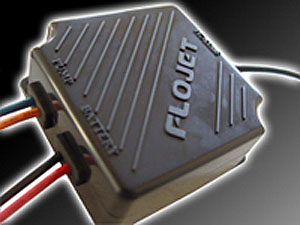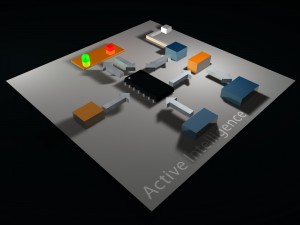Active Intelligence
What is Active Intelligence?
The underlying core technology of the AI system is a remotely activated, high-power switch using a low cost microcontroller which can monitor, control, and report the status of the load back to the point of switch activation . Thus is it becomes an intelligent, remotely controlled switch with diagnostics and protection built in.
Think of it as a very-intelligent, remotely controlled circuit breaker. A conventional circuit breaker normally performs only two functions: limiting the amount of current that can safely be delivered to a load, and acting as a master ON/OFF over-ride switch to the load.
The AI performs this function but much, much more:
• Since a conventional circuit breaker is placed in series with the activation switch, the entire wiring to and from the circuit breaker must be rated to safely carry the load current. This wire is often thick (low AWG (American Wire Gauge)) and hence is costly, heavy, and labor-intensive to route through a vehicle.
• AI “divorces” the control switch mechanism from the power switching function. Very low, safe levels of currents can be run between the actual control switch and the AI remote control device, so very small size wire (high AWG) can be routed between the switch and the AI, saving the cost, weight, and labor in a vehicle.
• Because the load switching and control switch are now “decoupled”, the control switch itself may be a low current pushbutton using “membrane” or “silicon rubber” technology as well as conventional electromechanical “rocker” or “toggle” switches. Thus it can remain backwards compatible with existing switch styles or allow upgrades to switch technology not previously available. It may even interface with “smart switch” technology using embedded LCD displays screens for advanced diagnostic and communication capabilities.
• Because the “circuit breaker” is remotely switched, it can be “Reset” or re-activated at the point of switch control, not at a difficult to access “breaker panel”.
Now a simple electromechanical circuit breaker can only protect against one malfunction-excessive current drain, usually double or more times the normal current drain.
AI can monitor the current drain and intelligently control the current:
• With intelligent monitoring and application-specific software, large inrush currents can be “allowed” for longer periods of time than a simple circuit breaker would tolerant. Conversely, currents, which are only 20-30% above “normal” levels, can be used to safely disconnect the load to prevent damage.
• With intelligent monitoring and application-specific software, low currents can also be detected and used to disconnect the load and the resulting information remotely displayed via the control switch itself. For example, a motor load that has been disconnected due to thermal overload, open motor windings, or wiring breakage would draw little or no current. This malfunction would be detected and remotely displayed.
• With intelligent monitoring and application-specific software, unique load current or voltage variations can be used to actively disconnect the load under pre-determined conditions. For example, many fluid pumps using centrifugal or flexible-impeller pump designs cannot safely run for extended periods of time without the fluid present (“run-dry” condition). AI can detect and safely disconnect the load under these conditions as well as displaying to the user the reason why the load has been disconnected. Also in some applications it is not desirable to operate the load with extremely LOW or HIGH voltages present on the power source. AI can detect and safely disconnect the load under these conditions.
What about application specific requirements beyond the normal “intelligent circuit breaker” domain? Again, with application-specific software and intelligent monitoring AI can:
• Condition or qualify the load control with another variable such as time. For example, in a normal vehicle if the control switches and circuit breakers are in the ON position, the load will be activated whenever a power source is applied, such as a battery or generator. This can cause a large inrush or drain on the power supply when initially applied to a vehicle. With application specific software, AI can delay the application power to the load by a preset amount, such as 5, 10, or 60 seconds to allow the power to stabilize. Likewise, some applications may need to be powered up for limited amounts of times, such as 10 or 20 minutes. AI can easily add these timed functions to the system control with no additional cost.
• Condition or qualify the load control with another variable such as pressure or vacuum. For example, the presence or absence of pressure or vacuum can be indicative of a loss of fluid in a pump, a blockage, a break, etc. AI can safely disconnect the load and display the diagnostic to the user at the point of switch control.
AI units may be networked with third-party displays and monitoring equipment as part of overall system control and monitoring strategy for vehicles or vessels:
• For example a central computer system may need to control lighting via a networked AI arrangement. It can display the status of any load controlled by an AI unit. It may command an AI unit to over-ride the local control that is present via the electro-mechanical switch. For example, perhaps a central computer monitoring system decides to turn-off lighting in an un-occupied room to converse energy. It can command the light loads to be turned OFF via the network AI connection and the status would display as OFF. However, the user may wish to turn the lights ON in a dark room by simply activating the local switch. The AI unit would take this new command, turn the lights ON, and send the new status to the central computer control and monitoring equipment.







